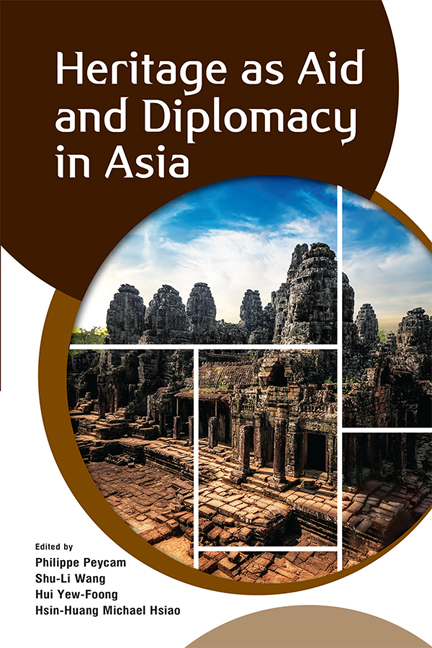Book contents
- Frontmatter
- Contents
- Contributors
- 1 Heritage as Aid and Diplomacy in Asia: An Introduction
- 2 World Heritage and WikiLeaks: Territory, Trade and Temples on the Thai-Cambodian Border
- 3 Heritage Making – Aid For Whom? The Genealogy of Expert Reports in the Hands of Politics and Their Impact in the Case of Preah Vihear
- 4 The International Coordinating Committee for Angkor: A World Heritage Site as an Arena of Competition, Connivance and State(s) Legitimation
- 5 Legacies of Cultural Philanthropy in Asia
- 6 To Help or Make Chaos? An Ethnography of Dutch Expertise in Postcolonial Indonesia
- 7 Heritage Conservation as a Tool for Cultural Diplomacy: Implications for the Sino-Japanese Relationship
- 8 From Ideological Alliance to Identity Clash: The Historical Origin of the Sino-Korean Goguryeo Controversies
- 9 Nationalism, Politics and the Practice of Archaeology in Afghanistan: A Case Study of Bamiyan
- 10 Disappearing Voices: The Politics and Practice of Safeguarding Kunqu Opera in the People’s Republic of China
- 11 Neoliberalizing Heritage: International Agencies and the Local Dynamics of Heritage Conservation in Bali, Indonesia
- 12 Heritage Conservation as Trickle-Down Development
- Index
5 - Legacies of Cultural Philanthropy in Asia
Published online by Cambridge University Press: 10 November 2020
- Frontmatter
- Contents
- Contributors
- 1 Heritage as Aid and Diplomacy in Asia: An Introduction
- 2 World Heritage and WikiLeaks: Territory, Trade and Temples on the Thai-Cambodian Border
- 3 Heritage Making – Aid For Whom? The Genealogy of Expert Reports in the Hands of Politics and Their Impact in the Case of Preah Vihear
- 4 The International Coordinating Committee for Angkor: A World Heritage Site as an Arena of Competition, Connivance and State(s) Legitimation
- 5 Legacies of Cultural Philanthropy in Asia
- 6 To Help or Make Chaos? An Ethnography of Dutch Expertise in Postcolonial Indonesia
- 7 Heritage Conservation as a Tool for Cultural Diplomacy: Implications for the Sino-Japanese Relationship
- 8 From Ideological Alliance to Identity Clash: The Historical Origin of the Sino-Korean Goguryeo Controversies
- 9 Nationalism, Politics and the Practice of Archaeology in Afghanistan: A Case Study of Bamiyan
- 10 Disappearing Voices: The Politics and Practice of Safeguarding Kunqu Opera in the People’s Republic of China
- 11 Neoliberalizing Heritage: International Agencies and the Local Dynamics of Heritage Conservation in Bali, Indonesia
- 12 Heritage Conservation as Trickle-Down Development
- Index
Summary
I
There is little doubt that American philanthropy, including activities in developing countries, is experiencing fundamental shifts. Often defined as “using private wealth for public good”, philanthropy has been practised in the United States for more than a century within a particular framework shaped by American laws, which made it possible for philanthropists to minimize their tax burden by giving away wealth for what are defined as “charitable purposes”.
Primarily as a result of new technologies created by large and successful corporations, there is now a group of tremendously wealthy entrepreneurs and investors seeking to redefine the purposes and methods of philanthropic practice. Often called “philanthrocapitalists”, these entrepreneurs assert that being successful in business gives them the know-how to solve large-scale problems of poverty and deprivation. Their philanthropic organizations promote “business-like ways of working, business-like efficiency, and market-driven solutions to social problems” (Feinstein 2011). Instead of the “bottom line” of corporate profit, they promise a “bottom line” of social impact. Along with bottom-line thinking comes an emphasis on measuring outcomes and tangible results. The language of metrics, benchmarks, risk-reward ratios and scaling up now pervades the discourse of new philanthropies, making staff and their boards even more eager to see results quickly.
In a new book, David Callahan scrutinizes major living donors, who he argues are forming a “heterogeneous new power elite” (Callahan 2017). He describes activist megadonors who want to be celebrated for carrying out their philanthropic mission, and who maintain close personal control over their foundations, noting how in many cases donors are determined to give away all their wealth for specific purposes during their lifetimes, rather than leaving behind foundations that could evolve and chart new directions in perpetuity. The proponents of what is nowadays termed “venture philanthropy” do appear more activist than earlier generations of foundation executives. Venture philanthropists craft social media messages to explain their goals, and have created a celebrity culture of giving away wealth.
- Type
- Chapter
- Information
- Heritage as Aid and Diplomacy in Asia , pp. 117 - 142Publisher: ISEAS–Yusof Ishak InstitutePrint publication year: 2020

